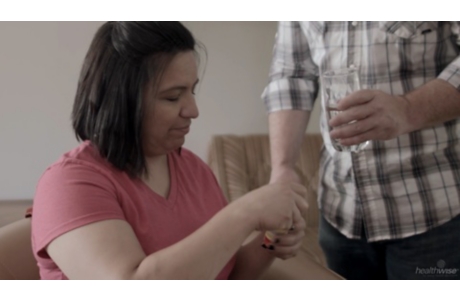Tubal Ligation and Tubal Implants
Surgery Overview
Tubal ligation, often referred to as “having your tubes tied,” is a surgical procedure in which a woman’s fallopian tubes are blocked, tied, or cut. Tubal implants, such as Essure, are small metal springs that are placed in each fallopian tube in a nonsurgical procedure (no cutting is involved). Over time, scar tissue grows around each implant and permanently blocks the tubes. Either procedure stops eggs from traveling from the ovaries into the fallopian tubes, where the egg is normally fertilized by a sperm.
Tubal ligation and tubal implants are considered to be permanent methods of birth control for women. They are usually done by a gynecologist. They may also be done by a family medicine doctor or a general surgeon.
Tubal ligation method
There are several different ways of closing the fallopian tubes, including clipping or banding them shut or cutting and stitching or burning them closed. Your surgeon will probably prefer one of these tubal ligation methods.
A tubal ligation can be done using a:
- A laparoscopy or mini-lap. These are done by inserting a viewing instrument and surgical tools through two small incisions (laparoscopy) or one small incision (mini-lap) in the abdomen.
- Postpartum tubal ligation. This is usually done as a mini-laparotomy after childbirth. The fallopian tubes are higher in the abdomen right after pregnancy, so the incision is made below the belly button (navel). The procedure is often done within 24 to 36 hours after the baby is delivered.
An open tubal ligation (laparotomy) is done through a larger incision in the abdomen. It may be recommended if you need abdominal surgery for other reasons (such as a cesarean section) or have had pelvic inflammatory disease (PID), endometriosis, or previous abdominal or pelvic surgery. These conditions often cause scarring or sticking together (adhesion) of tissue and organs in the abdomen. Scarring or adhesions can make one of the other types of tubal ligation more difficult and risky.
Laparoscopy is usually done with a general anesthetic. Laparotomy or mini-laparotomy can be done using general anesthesia or a regional anesthetic, also known as an epidural.
Reversing a tubal ligation is possible, but it isn’t highly successful. This is why tubal ligation is considered a permanent method of birth control.
Tubal implant method
Implants, such as Essure, are inserted in the fallopian tubes without surgery or general anesthesia. The procedure is done in a doctor’s office, an outpatient surgery center, or a hospital, and it doesn’t require an overnight stay. The implant procedure itself takes about 10 minutes.
- Before the procedure, your cervix is first opened (dilated) to reduce the risk of injury to the cervix. Your doctor will use a speculum and a dilating instrument to gradually open the cervix just before the procedure.
- For the procedure, you are positioned as you would be for a pelvic exam. Your doctor passes a thin tube (catheter) through your vagina and cervix, into the uterus, and then into a fallopian tube. The catheter is used to place an implant into a fallopian tube. An implant is then placed in the other fallopian tube the same way. You may have some menstrual-like cramps afterwards.
After the procedure, an X-ray is taken to make sure the implants are in place and the tubes are closed.
In some cases, a tubal implant can be difficult to insert. Should this happen, a second procedure is needed to completely block both tubes.
For the first 3 months after insertion, you must use another method of birth control. At 3 months, dye is injected into your uterus and an X-ray is taken (hysterosalpingography) to make sure that the implants are in place and the tubes are fully blocked by scar tissue. If they are, you will no longer have to use another method of birth control.
Advantages
Tubal ligation and tubal implants are permanent methods of birth control and allow you to be sexually active without worrying about becoming pregnant.
Although tubal ligation and tubal implants are expensive, it is a one-time cost. These procedures are usually covered by medical insurance, and there are no costs after the surgery is done. The cost of other birth control methods, such as pills or condoms and spermicide, may be greater over time.
Disadvantages
Tubal ligation and tubal implants do not protect against sexually transmitted infections (STIs), including infection with the human immunodeficiency virus (HIV). To help protect yourself and your partner from possible STIs, use a condom every time you have sex.
You must use another form of birth control for 3 months after receiving tubal implants.
What To Expect
Tubal ligation
After a tubal ligation, you will most likely go home the same day. Your surgeon will give you instructions on what to expect and when to call after the surgery.
- You may have some slight vaginal bleeding caused by the movement of your uterus during the surgery.
- If you had a laparoscopy, your stomach may be swollen (distended) from the gas that was used to lift your skin and muscles away from your abdominal organs so the surgeon could see them better. This should go away within a day or so but may last longer. You may also have some back or shoulder pain from the gas in your abdomen. This will go away as your body absorbs the gas.
- You can shower 24 hours after the surgery, but avoid rubbing or pulling on your incision for at least a week.
- You can have sexual intercourse as soon as you feel like it and it does not cause pain, which is usually 1 week after surgery.
- Be sure to rest for a few days (or at least 24 hours) before beginning to resume your normal activities. You should be able to resume all activities within a week.
- No backup method of birth control is needed after the surgery.
A follow-up exam in 2 weeks is usually scheduled.
Tubal implants
- Most women can return to normal activities the same day as the procedure. You may have cramps, vaginal bleeding, or discomfort in your pelvis or back.
- Be sure to use another method of birth control for 3 months, until an X-ray confirms that the fallopian tubes are blocked.
Why It Is Done
A tubal ligation or tubal implant placement is a permanent method of birth control. Only consider this method when you are sure that you will not want to become pregnant in the future.
How Well It Works
Tubal ligation and tubal implants are not 100% effective at preventing pregnancy.
Tubal ligation
- There is a slight risk of becoming pregnant after tubal ligation. This happens to about 5 out of 1,000 women after 1 year. After a total of 5 years following tubal ligation, about 13 out of 1,000 women will have become pregnant.footnote 1
- Pregnancy may occur if:
- The tubes grow back together or a new passage forms (recanalization) that allows an egg to be fertilized by sperm. Your doctor can discuss which method of ligation is more effective for preventing tubes from growing back together.
- The surgery was not done correctly.
- You were pregnant at the time of surgery.
Tubal implants
- Studies show that over 2 years, fewer than 1 out of 100 women with implants got pregnant.footnote 1
- A tubal implant can be difficult to insert. Some women have to have a repeat procedure before both tubal implants are properly placed.
Call your doctor immediately if you have had tubal ligation or tubal implants and you have:
- Symptoms of pregnancy, such as a missed menstrual period, breast tenderness, and nausea.
- Pain on one side of your lower abdomen and you feel faint or dizzy.
Risks
Tubal ligation. Major complications of tubal ligation aren’t common.
- Minor complications include infection and wound separation.
- Major complications include heavy blood loss, general anesthesia problems, organ injury during surgery, and need for a larger laparotomy incision during surgery.
Although fewer complications occur with laparoscopy than with other kinds of tubal ligation surgery, these complications can be more serious. For example, in rare cases, the bowel or bladder is injured when the laparoscope is inserted.
The general risks of surgery are greater if you have diabetes, are overweight, smoke, or have a heart condition.
Tubal implants. Most women who have tubal implants don’t have problems. Some women do have problems, such as:
- Pelvic pain.
- Rash or itching, if she is allergic to nickel.
- Movement of the implant through a fallopian tube into her belly or pelvis.
- A break in the wall of her uterus or fallopian tube.
About 2 to 3 out of 100 women who have Essure will need another operation within 1 year.footnote 2
Before you receive implants, you may be tested to make sure that you don’t have a vaginal infection or a sexually transmitted infection (STI).
Ectopic pregnancy risk
If a tubal ligation or implant fails and you become pregnant, you have an increased risk of having an ectopic pregnancy. Ectopic pregnancies can occur years after the tubal ligation and are most likely 3 or more years after the procedure. footnote 3To learn more, see the topic Ectopic Pregnancy.
What To Think About
Tubal ligation and tubal implants do not change your monthly menstrual cycle. You will still release an egg each month (ovulate) and have menstrual periods. You will go through menopause at the same time that you would have if you hadn’t had the surgery. Your sexual desires won’t change, although you may feel more relaxed about having sex because you don’t have to worry about becoming pregnant.
Other things to think about
Reversing tubal ligation or removing tubal implants requires major surgery, and success rates are very low. If you are considering tubal ligation or tubal implants, be absolutely certain that you will never want to have a biological child in the future.
- Health insurance coverage may require a waiting period from 48 hours to 30 days under most circumstances.
- Some doctors advise a waiting period between the time a woman requests a tubal ligation or tubal implants and the time the procedure is performed. This waiting period allows you to be certain about your decision.
References
Citations
- Roncari D, Jou MY (2011). Female and male sterilization. In RA Hatcher, et al., eds., Contraceptive Technology, 20th rev. ed., pp. 435–482. New York: Ardent Media.
- Mao J, et al. (2015) Safety and efficacy of hysteroscopic sterilization compared with laparoscopic sterilization: An observational cohort study. BMJ. DOI: 10.1136/bmj.h5162. Accessed November 12, 2015.
- Speroff L, Darney PD (2011). Sterilization. In A Clinical Guide for Contraception, 5th ed., pp. 381–404. Philadelphia: Lippincott Williams and Wilkins.
Other Works Consulted
- U.S. Food and Drug Administration (2015). Essure benefits and risks. U.S. Food and Drug Administration. http://www.fda.gov/MedicalDevices/ProductsandMedicalProcedures/ImplantsandProsthetics/EssurePermanentBirthControl/ucm452250.htm?source=govdelivery&utm_medium=email&utm_source=govdelivery. Accessed July 9, 2015.
Credits
Current as of: May 29, 2019
Author: Healthwise Staff
Medical Review:Sarah A. Marshall, MD – Family Medicine & Kathleen Romito, MD – Family Medicine & Martin J. Gabica, MD – Family Medicine & Adam Husney, MD – Family Medicine & Rebecca Sue Uranga, MD – Obstetrics and Gynecology
Current as of: May 29, 2019
Author: Healthwise Staff
Medical Review:Sarah A. Marshall, MD – Family Medicine & Kathleen Romito, MD – Family Medicine & Martin J. Gabica, MD – Family Medicine & Adam Husney, MD – Family Medicine & Rebecca Sue Uranga, MD – Obstetrics and Gynecology
This information does not replace the advice of a doctor. Healthwise, Incorporated, disclaims any warranty or liability for your use of this information. Your use of this information means that you agree to the Terms of Use. Learn how we develop our content.










